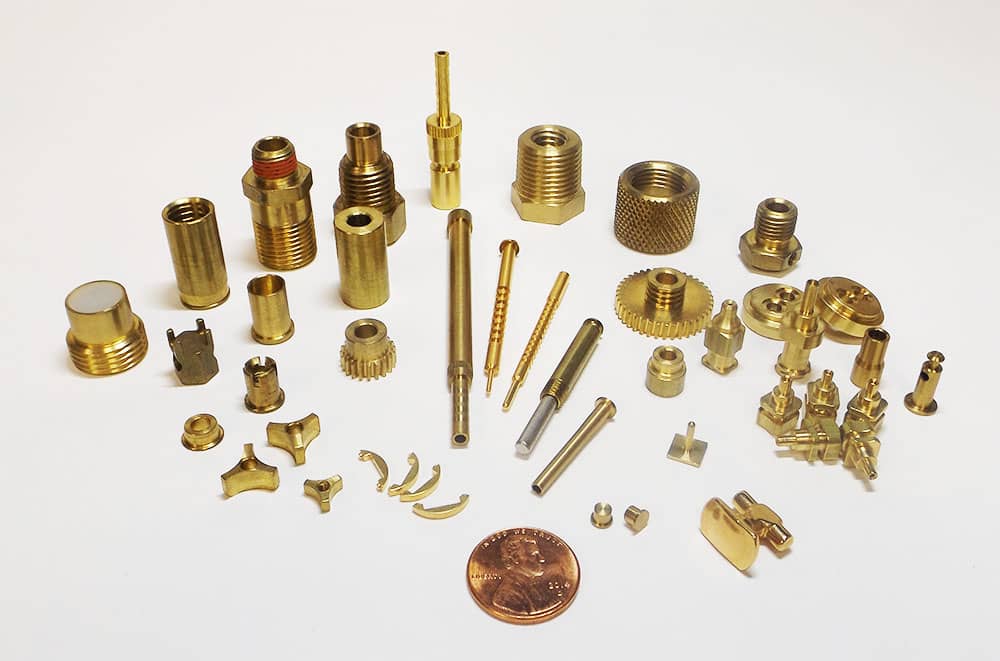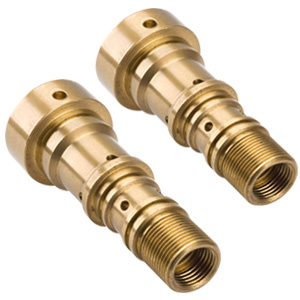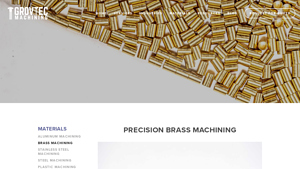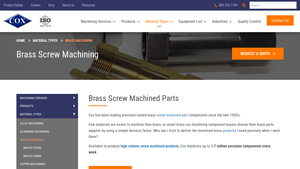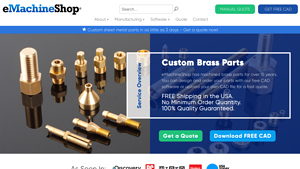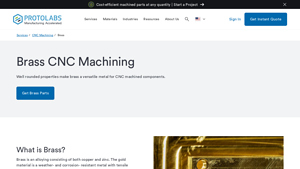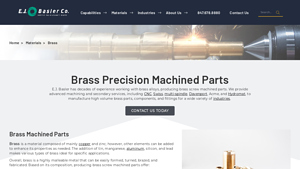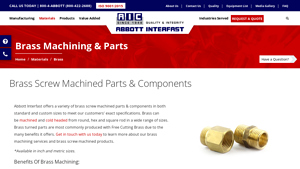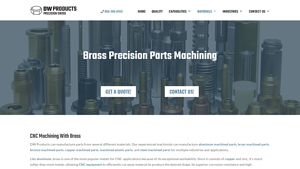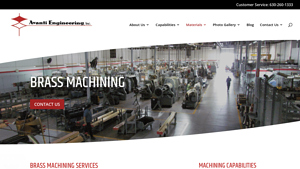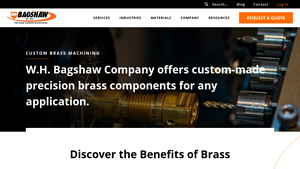Brass Machined Parts Guide: Type, Cost, Top List…
Introduction: Navigating the Global Market for brass machined parts
In the complex landscape of global manufacturing, sourcing high-quality brass machined parts presents a unique set of challenges for international B2B buyers. With the material’s superior machinability and exceptional corrosion resistance, brass components are indispensable in industries ranging from electronics to plumbing. However, navigating the myriad of suppliers, understanding material specifications, and ensuring compliance with international standards can be daunting. This guide aims to demystify the process, offering a comprehensive overview of brass machined parts, including various types, applications, and essential considerations for supplier vetting.
Buyers from regions such as Africa, South America, the Middle East, and Europe—countries like Vietnam and Germany—will find actionable insights tailored to their specific needs. We will delve into crucial topics such as cost analysis, quality assurance measures, and logistical considerations, empowering you to make informed purchasing decisions. By understanding the nuances of brass machining processes and the competitive landscape of suppliers, you will be better positioned to secure reliable partnerships and optimize your supply chain. This guide is your resource for navigating the global market, ensuring that you can procure the right brass machined parts efficiently and effectively.
Understanding brass machined parts Types and Variations
| Type Name | Key Distinguishing Features | Primary B2B Applications | Brief Pros & Cons for Buyers |
|---|---|---|---|
| Brass Fittings | High corrosion resistance, excellent sealing properties | Plumbing, HVAC, Oil & Gas | Pros: Durable and reliable; Cons: Higher initial cost |
| Brass Gears | Precision-engineered, available in various sizes | Automotive, Industrial Machinery | Pros: High durability; Cons: Limited load capacity |
| Brass Screws | Easy to machine, good strength-to-weight ratio | Electronics, Consumer Products | Pros: Cost-effective; Cons: May corrode in harsh environments |
| Brass Valves | Versatile designs for fluid control | Water Supply, Chemical Processing | Pros: Excellent flow control; Cons: Can be heavy |
| Brass Bushings | Low friction coefficient, good wear resistance | Automotive, Aerospace | Pros: Extended lifespan; Cons: May require lubrication |
What Are Brass Fittings and Their Key Characteristics?
Brass fittings are essential components in plumbing and HVAC applications, known for their high corrosion resistance and ability to create tight seals. They are often used in environments where fluid flow is critical, such as in oil and gas pipelines. When sourcing brass fittings, buyers should consider the specific environmental conditions and the compatibility of the fitting material with the fluids being transported. This ensures longevity and reliability in performance.
How Do Brass Gears Stand Out in Industrial Applications?
Brass gears are precision-engineered components widely utilized in automotive and industrial machinery. Their manufacturing process allows for various sizes and shapes, making them versatile for different applications. Buyers should prioritize quality and precision when selecting brass gears, as the performance and efficiency of machinery depend significantly on the accuracy of these components. Consideration of load capacity and operational conditions is also crucial to avoid premature wear.
Why Choose Brass Screws for Your Manufacturing Needs?
Brass screws are favored in electronics and consumer product applications due to their ease of machining and favorable strength-to-weight ratio. They are cost-effective solutions that provide reliable fastening options. When purchasing brass screws, buyers should evaluate the environmental conditions of their application, as exposure to moisture can lead to corrosion. Additionally, understanding the specific size and threading requirements is essential for optimal performance.
What Advantages Do Brass Valves Offer in Fluid Control?
Brass valves are widely recognized for their versatility in fluid control applications, particularly in water supply and chemical processing. They provide excellent flow control due to their durable construction and resistance to corrosion. Buyers should consider the pressure and temperature ratings of brass valves to ensure they meet the specific needs of their systems. It is also advisable to assess the valve design to confirm compatibility with existing infrastructure.
How Do Brass Bushings Enhance Performance in Mechanical Systems?
Brass bushings are critical components in automotive and aerospace applications, known for their low friction coefficients and good wear resistance. They help reduce friction and wear between moving parts, thus extending the lifespan of machinery. When procuring brass bushings, buyers should focus on the specific operational conditions and lubrication requirements to maximize performance. Proper sizing and fitment are also essential to achieve optimal functionality in mechanical systems.
Key Industrial Applications of brass machined parts
| Industry/Sector | Specific Application of brass machined parts | Value/Benefit for the Business | Key Sourcing Considerations for this Application |
|---|---|---|---|
| Aerospace | Connectors and fasteners | High reliability and lightweight, crucial for aircraft safety | Certifications and compliance with aerospace standards |
| Oil & Gas | Valve components | Corrosion resistance and durability in harsh environments | Material certifications and supply chain reliability |
| Medical Devices | Surgical instruments and fittings | Precision and biocompatibility, essential for patient safety | Strict adherence to medical standards and quality control |
| Electronics | Connectors and housings | Excellent conductivity and corrosion resistance | Compatibility with electronic specifications |
| Plumbing | Fittings and valves | Leak-proof sealing and durability under pressure | Compliance with plumbing codes and standards |
How Are Brass Machined Parts Used in Aerospace Applications?
In the aerospace sector, brass machined parts are often utilized for connectors and fasteners due to their lightweight properties and high reliability. These components are critical for ensuring the safety and performance of aircraft systems. Aerospace buyers must prioritize suppliers that comply with stringent industry standards and certifications, such as AS9100, to ensure quality and reliability. Additionally, international buyers should consider logistics and delivery timelines to maintain production schedules.
What Role Do Brass Machined Parts Play in the Oil & Gas Industry?
Brass machined parts serve as vital components in the oil and gas industry, particularly in valves and fittings, where corrosion resistance and durability are paramount. These parts must withstand extreme environmental conditions, including high pressure and exposure to corrosive substances. Buyers in this sector should seek suppliers that can provide certified materials and demonstrate a reliable supply chain, particularly when operating in remote areas of Africa or South America where logistical challenges may arise.
Why Are Brass Machined Parts Essential for Medical Devices?
In the medical device industry, brass machined parts are critical for surgical instruments and fittings that require precision and biocompatibility. These components must meet rigorous quality standards, as they directly impact patient safety. International B2B buyers must ensure that their suppliers adhere to ISO 13485 and other relevant medical device regulations, while also considering the supplier’s ability to offer traceability and quality assurance throughout the manufacturing process.
How Are Brass Machined Parts Used in Electronics?
Brass machined parts are widely used in the electronics industry for connectors and housings, where their excellent conductivity and corrosion resistance are vital. These components help ensure reliable electrical connections in devices ranging from consumer electronics to industrial machinery. Buyers should focus on suppliers that can meet specific electronic industry standards, such as IPC-A-610, while also providing rapid prototyping and customization options to meet diverse design requirements.
What Applications Do Brass Machined Parts Have in Plumbing?
In plumbing applications, brass machined parts such as fittings and valves are essential for creating leak-proof seals and ensuring durability under pressure. The low friction coefficient of brass makes it an ideal choice for these components, which must perform reliably over time. Buyers in this sector should prioritize sourcing from manufacturers that comply with local plumbing codes and standards, ensuring that the products can withstand the demands of both residential and commercial installations.
3 Common User Pain Points for ‘brass machined parts’ & Their Solutions
Scenario 1: Difficulty in Ensuring Consistent Quality of Brass Machined Parts
The Problem: One of the most significant challenges B2B buyers face when sourcing brass machined parts is ensuring consistent quality across batches. Variability in machining processes, material quality, and supplier capabilities can lead to discrepancies in dimensions, finishes, and tolerances, which in turn can affect the functionality and reliability of the final product. For companies in industries like aerospace and medical, where precision is paramount, even minor defects can have severe consequences, leading to costly rework, delays, and potential safety issues.
The Solution: To overcome quality inconsistencies, buyers should implement a robust supplier evaluation process. This involves asking for detailed quality assurance practices from potential suppliers, such as ISO certifications and in-house testing capabilities. Buyers should also request samples and conduct their own quality inspections before committing to large orders. Additionally, establishing clear specifications and tolerances in the purchase agreements will help ensure that suppliers understand the exact requirements. Regular communication and performance reviews can foster a collaborative relationship, enabling suppliers to address issues proactively and maintain quality standards consistently.
Scenario 2: Challenges in Material Selection for Specific Applications
The Problem: Selecting the right brass alloy for a specific application can be overwhelming, especially given the variety of brass types available, each with unique properties. For instance, while some alloys offer excellent corrosion resistance, others may be more suitable for machining or electrical conductivity. This can lead to incorrect material choices that compromise product performance, durability, or compliance with industry standards, particularly in sectors like plumbing or electronics.
The Solution: B2B buyers should engage in thorough research and consultation with material experts before making decisions. Understanding the application requirements—such as environmental conditions, load-bearing needs, and regulatory compliance—is crucial. Collaborating with suppliers who can provide insights into the properties of different brass alloys can lead to better-informed choices. Buyers should also consider requesting custom formulations or modifications from suppliers to meet specific application demands. Utilizing tools such as material property databases can aid in selecting the best alloy for the intended use.
Scenario 3: Long Lead Times Affecting Production Schedules
The Problem: Many B2B buyers encounter long lead times for brass machined parts, which can severely impact their production schedules. Delays in sourcing these components can lead to halted production lines, missed deadlines, and ultimately, lost revenue. This is particularly critical in industries where time-to-market is essential, and companies cannot afford setbacks.
The Solution: To mitigate lead time issues, buyers should adopt a proactive supply chain management strategy. This includes diversifying their supplier base to include both local and international sources, allowing for faster turnaround times depending on demand. Implementing a just-in-time (JIT) inventory system can also help ensure that parts are available when needed without overstocking. Additionally, buyers should communicate their production schedules and forecast needs with suppliers, fostering a partnership that enables suppliers to prioritize their orders. Establishing contingency plans with backup suppliers can further ensure continuity in case of unforeseen delays.
Strategic Material Selection Guide for brass machined parts
What Are the Key Properties of Common Brass Alloys for Machined Parts?
Brass is an alloy primarily composed of copper and zinc, with various grades tailored for specific applications. The most common brass alloys used in machining include C36000, C35300, and C23000. Each of these materials offers unique properties that influence their performance in different environments.
C36000 Brass: The Versatile Choice for Precision Machining
C36000, often referred to as free-cutting brass, is renowned for its excellent machinability and is widely used in precision applications. It features a high copper content, which provides good corrosion resistance and thermal conductivity. This alloy can withstand moderate temperatures and pressures, making it suitable for a variety of applications, including fittings and fasteners.
Pros: C36000 is easy to machine, offers good corrosion resistance, and is cost-effective for high-volume production. Its excellent surface finish is advantageous for aesthetic components.
Cons: While durable, it may not perform well in extreme environments, such as those involving high temperatures or aggressive chemicals.
Impact on Application: C36000 is compatible with water and various gases, making it ideal for plumbing and HVAC applications. However, it may not be suitable for applications involving saltwater or acidic environments.
Considerations for International Buyers: Compliance with ASTM standards is crucial, especially for buyers in Europe and the Middle East. Understanding local regulations regarding lead content is also essential, as some regions have stringent restrictions.
C35300 Brass: The Corrosion-Resistant Alternative
C35300 brass is another popular choice, particularly in applications requiring enhanced corrosion resistance. This alloy contains a small amount of lead, which improves machinability while maintaining strength and ductility.
Pros: C35300 exhibits excellent corrosion resistance, making it suitable for marine applications and environments exposed to moisture. It also provides good wear resistance, which is beneficial in moving parts.
Cons: The presence of lead can limit its use in certain applications due to health and environmental regulations. Additionally, its higher cost compared to C36000 may deter some buyers.
Impact on Application: This alloy is particularly effective in applications where exposure to seawater or humid conditions is prevalent. Its durability makes it a preferred choice for marine fittings and valves.
Considerations for International Buyers: Buyers should ensure compliance with local regulations regarding lead content, especially in regions like Europe, where restrictions are more stringent. Familiarity with DIN standards can also be beneficial.
C23000 Brass: The Decorative and Functional Option
C23000, or red brass, is characterized by its reddish hue and is often used in decorative applications. This alloy offers good corrosion resistance and is highly malleable, making it suitable for intricate designs.
Pros: C23000 is aesthetically pleasing and offers good corrosion resistance, making it ideal for decorative components. Its malleability allows for complex shapes without compromising strength.
Cons: While it performs well in decorative applications, its mechanical properties may not be as robust as other brass alloys under heavy loads or high-pressure conditions.
Impact on Application: C23000 is often used in architectural fittings and decorative hardware. Its compatibility with various media makes it suitable for low-pressure applications.
Considerations for International Buyers: Buyers should consider the aesthetic preferences of their market. Understanding compliance with local standards, such as JIS in Japan or ASTM in the U.S., will also be crucial.
Summary Table of Brass Alloys for Machined Parts
| Material | Typical Use Case for brass machined parts | Key Advantage | Key Disadvantage/Limitation | Relative Cost (Low/Med/High) |
|---|---|---|---|---|
| C36000 Brass | Plumbing fittings, fasteners | Excellent machinability and surface finish | Limited performance in extreme environments | Medium |
| C35300 Brass | Marine fittings, valves | Superior corrosion resistance | Lead content may restrict usage | High |
| C23000 Brass | Decorative hardware, architectural fittings | Aesthetic appeal and malleability | Weaker under high loads | Medium |
This guide provides essential insights into the strategic selection of brass materials for machined parts, enabling B2B buyers to make informed decisions tailored to their specific needs and compliance requirements.
In-depth Look: Manufacturing Processes and Quality Assurance for brass machined parts
What Are the Key Stages in Manufacturing Brass Machined Parts?
Brass machined parts undergo a series of well-defined manufacturing processes that ensure precision and quality. Understanding these stages helps international B2B buyers identify reliable suppliers who can meet their specific needs.
1. Material Preparation
The initial step involves selecting the appropriate brass alloy, typically a combination of copper and zinc, sometimes with small amounts of lead to enhance machinability. The chosen alloy is then cut into manageable lengths, often referred to as bar stock. This preparation is crucial as it directly impacts the machining process and the final product’s quality.
2. Forming Techniques Used in Brass Machining
After material preparation, the forming stage begins. This can involve several advanced techniques, including:
-
CNC Turning: This process is essential for producing cylindrical components. The brass material is rotated against cutting tools, creating precise shapes and dimensions.
-
CNC Milling: For parts requiring complex geometries, CNC milling machines utilize rotating cutters to remove material from a stationary workpiece. This technique is particularly useful for intricate designs.
-
Swiss Machining: Ideal for high-volume production, Swiss machining allows for the rapid creation of small, precise components through a series of automated operations.
-
Multi-Spindle Machining: This method enhances efficiency by allowing multiple parts to be machined simultaneously, reducing production time and costs.
Each of these techniques plays a vital role in ensuring that the brass parts meet the exact specifications required by the end application, whether in automotive, aerospace, or medical industries.
3. Assembly of Brass Components
In some cases, machined brass parts may require assembly with other components. This stage necessitates precision fitting and often involves manual or automated processes to ensure that all parts integrate seamlessly. Proper assembly is critical, especially for applications where pressure or electrical conductivity is involved.
4. Finishing Processes for Brass Machined Parts
The final stage in the manufacturing process is finishing, which enhances both the aesthetic and functional properties of the brass parts. Common finishing techniques include:
-
Polishing: To achieve a smooth surface and improve corrosion resistance, polishing is often employed.
-
Plating: Adding a layer of material (such as nickel or chrome) can further protect the brass from environmental factors and enhance appearance.
-
Surface Treatments: Techniques such as anodizing or powder coating can be applied to improve durability and appearance, depending on the intended use of the parts.
How Is Quality Assurance Implemented in Brass Machining?
Quality assurance (QA) is paramount in the brass machining industry, ensuring that the final products meet both international and industry-specific standards. B2B buyers should familiarize themselves with these QA processes to assess potential suppliers effectively.
What International Standards Apply to Brass Machined Parts?
Many manufacturers adhere to international quality standards, with ISO 9001 being one of the most recognized. This standard focuses on effective quality management systems and customer satisfaction. Additionally, industry-specific certifications such as CE (Conformité Européenne) and API (American Petroleum Institute) are crucial for sectors like medical and oil & gas.
What Are the Key QC Checkpoints During Production?
Quality control involves several checkpoints throughout the manufacturing process:
-
Incoming Quality Control (IQC): This initial inspection verifies that the raw materials meet specified standards before they enter production.
-
In-Process Quality Control (IPQC): Continuous monitoring during the machining process ensures that parts remain within specified tolerances. This may involve statistical process control (SPC) techniques.
-
Final Quality Control (FQC): After machining and finishing, a thorough inspection is conducted to ensure all specifications and standards are met before parts are shipped.
What Testing Methods Are Commonly Used?
Several testing methods are employed to validate the quality of brass machined parts, including:
-
Dimensional Inspection: Using calipers and micrometers to ensure parts meet design specifications.
-
Non-Destructive Testing (NDT): Techniques such as ultrasonic testing and dye penetrant testing help identify material defects without damaging the parts.
-
Functional Testing: This assesses whether the parts perform as intended in their final application, which is especially critical in industries like aerospace and medical.
How Can B2B Buyers Verify Supplier Quality Control?
For international B2B buyers, verifying a supplier’s quality control measures is essential for ensuring consistent product quality. Here are several strategies to consider:
1. Conducting Supplier Audits
Regular audits of suppliers can provide insights into their manufacturing processes and quality assurance practices. During these audits, buyers can assess compliance with ISO and other relevant standards, ensuring that the supplier maintains high-quality standards.
2. Requesting Quality Reports and Certifications
Buyers should request documentation that outlines the supplier’s quality control procedures, including reports from IQC, IPQC, and FQC processes. Certificates of compliance with international standards like ISO 9001 can also serve as a valuable indicator of quality assurance commitment.
3. Utilizing Third-Party Inspections
Engaging third-party inspection agencies can provide an unbiased assessment of the supplier’s quality control measures. These agencies can conduct thorough inspections and testing, offering additional assurance that the machined brass parts meet required specifications.
What Nuances Should International Buyers Consider in Quality Certification?
When dealing with suppliers from diverse regions such as Africa, South America, the Middle East, and Europe, buyers should be aware of the nuances in quality certification. Variations in regional standards and practices can affect quality assurance processes. Buyers should ensure that their suppliers not only comply with international standards but also understand local regulations and market requirements.
By being informed about the manufacturing processes and quality assurance practices in brass machining, international B2B buyers can make better purchasing decisions, ensuring they partner with suppliers who prioritize quality and reliability.
Practical Sourcing Guide: A Step-by-Step Checklist for ‘brass machined parts’
This guide provides a comprehensive checklist for B2B buyers aiming to procure brass machined parts. By following these steps, you can ensure that you choose the right supplier and receive high-quality components that meet your specific requirements.
Step 1: Define Your Technical Specifications
Before engaging suppliers, clearly outline your project requirements. This includes dimensions, tolerances, surface finishes, and material specifications. Precise specifications help suppliers understand your needs, reducing the risk of errors and ensuring that the parts produced meet your expectations.
- Consider functionality: Determine the intended use of the parts and any relevant industry standards.
- Detail material properties: Specify the type of brass alloy required (e.g., C36000 or C35300) based on its mechanical and corrosion-resistant properties.
Step 2: Research Potential Suppliers
Conduct thorough research to identify potential suppliers who specialize in brass machining. Look for companies with a proven track record in your industry and positive customer reviews.
- Check online platforms: Utilize platforms like ThomasNet, Alibaba, or industry-specific directories.
- Evaluate supplier capabilities: Ensure they have the necessary equipment and technology (e.g., CNC machining, Swiss turning) to meet your production needs.
Step 3: Verify Supplier Certifications
It’s essential to verify that your suppliers hold relevant certifications, such as ISO 9001, which indicates a commitment to quality management. Certifications provide assurance that the supplier adheres to industry standards and best practices.
- Request documentation: Ask for copies of their quality certifications and any other relevant compliance documents.
- Look for industry-specific certifications: Depending on your application, certifications like AS9100 for aerospace or IATF 16949 for automotive may be critical.
Step 4: Evaluate Supplier Experience and Expertise
Assess the supplier’s experience in machining brass parts similar to your project. Their expertise can significantly impact the quality and reliability of the components produced.
- Request case studies: Ask for examples of past projects that demonstrate their ability to meet specific requirements.
- Inquire about engineering support: A supplier that offers design assistance can help optimize your part for manufacturability and cost-efficiency.
Step 5: Request Quotes and Compare Pricing
Once you’ve identified a shortlist of suppliers, request detailed quotes. Ensure that each quote includes the same specifications to facilitate accurate comparisons.
- Consider total cost of ownership: Evaluate not just the price but also factors like lead times, shipping costs, and potential discounts for bulk orders.
- Look for transparency: Suppliers should provide clear breakdowns of costs, including any setup fees or additional charges.
Step 6: Assess Communication and Customer Support
Effective communication is vital for a successful partnership. Assess how responsive and helpful potential suppliers are during the initial engagement phase.
- Gauge responsiveness: Are they quick to reply to inquiries and provide additional information?
- Evaluate support channels: Determine if they offer multiple communication methods (e.g., email, phone, chat) to address any issues that may arise during production.
Step 7: Conduct a Trial Order
Before committing to a large order, consider placing a small trial order to evaluate the supplier’s capabilities firsthand. This step allows you to assess the quality of the machined parts and the efficiency of their service.
- Monitor quality: Inspect the parts upon delivery to ensure they meet your specifications.
- Assess delivery performance: Evaluate if they meet agreed-upon timelines and packaging standards.
By following this checklist, B2B buyers can effectively navigate the sourcing process for brass machined parts, ensuring they select reliable suppliers who can deliver high-quality products tailored to their needs.
Comprehensive Cost and Pricing Analysis for brass machined parts Sourcing
What Are the Key Cost Components in Brass Machined Parts Sourcing?
When sourcing brass machined parts, understanding the cost structure is essential for making informed purchasing decisions. The primary cost components include:
-
Materials: Brass is an alloy primarily composed of copper and zinc. The specific alloy used can influence cost; for instance, C36000 brass is often favored for its machinability but may be more expensive than other grades. Pricing fluctuates based on market demand and availability, especially for raw materials.
-
Labor: Labor costs encompass the wages of skilled machinists and operators. High-quality machining often requires experienced personnel, which can increase costs. Additionally, labor rates vary significantly by region, with countries in Europe or North America generally having higher wages than those in Africa or South America.
-
Manufacturing Overhead: This includes indirect costs associated with production, such as utilities, equipment maintenance, and facility expenses. Efficient production processes can mitigate these costs, making it vital to assess a supplier’s operational efficiencies.
-
Tooling: Custom tooling may be necessary for specific parts, impacting overall costs. Investing in high-quality tooling can improve production efficiency and part quality, but it adds to initial costs.
-
Quality Control (QC): Implementing stringent QC processes ensures that parts meet required specifications. While this may increase upfront costs, it helps prevent costly rework or returns later, providing long-term savings.
-
Logistics: Transporting brass machined parts involves shipping costs, which can vary based on distance, weight, and chosen logistics partners. International shipments may incur additional fees such as customs duties and taxes, making it critical to factor these into total costs.
-
Margin: Suppliers will include a profit margin in their pricing. This margin can vary based on competition, supplier reputation, and the complexity of the machining required.
How Do Price Influencers Impact Brass Machined Parts Costs?
Several factors can significantly influence the pricing of brass machined parts:
-
Volume and Minimum Order Quantity (MOQ): Higher order volumes typically lead to lower per-unit costs due to economies of scale. Suppliers may offer discounts for bulk orders, making it advantageous to consolidate purchases.
-
Specifications and Customization: Custom parts with unique specifications generally cost more due to the additional machining required. Standard parts can be produced more economically.
-
Materials and Quality Certifications: The choice of brass alloy and required quality certifications (e.g., ISO standards) can impact pricing. Higher quality materials and certifications often lead to increased costs but can enhance reliability.
-
Supplier Factors: The supplier’s experience, reputation, and operational efficiency can affect pricing. Established suppliers may charge a premium, but they often provide better quality and reliability.
-
Incoterms: The terms of delivery (e.g., FOB, CIF) can influence total costs. Buyers should understand the implications of these terms on shipping responsibilities and costs to avoid unexpected expenses.
What Tips Can Help Buyers Optimize Costs for Brass Machined Parts?
-
Negotiation: Engage in discussions with suppliers to explore pricing flexibility. Highlighting long-term relationships or potential bulk orders can lead to better pricing.
-
Cost-Efficiency: Consider the Total Cost of Ownership (TCO), which encompasses not just the purchase price but also shipping, handling, and potential rework costs. Opting for a slightly higher upfront cost may yield savings in the long run through improved quality.
-
Pricing Nuances for International Buyers: Buyers from regions like Africa or South America should be aware of currency fluctuations and international shipping costs. Establishing relationships with local suppliers may reduce shipping expenses and lead times.
-
Requesting Quotes: Always obtain multiple quotes from different suppliers to ensure competitive pricing. This practice can also provide insight into market rates.
-
Understanding Market Trends: Staying informed about market trends affecting brass pricing can empower buyers to make strategic purchasing decisions, particularly in volatile economic climates.
By considering these factors and tips, B2B buyers can navigate the complexities of sourcing brass machined parts, ultimately leading to more cost-effective and strategic procurement decisions.
Alternatives Analysis: Comparing brass machined parts With Other Solutions
When considering manufacturing solutions for precision components, it’s essential to evaluate the available alternatives to brass machined parts. Each material and method comes with its own set of advantages and drawbacks, which can significantly impact performance, cost, and suitability for specific applications. Below, we explore how brass machined parts compare with aluminum and stainless steel machining, two common alternatives.
| Comparison Aspect | Brass Machined Parts | Aluminum Machined Parts | Stainless Steel Machined Parts |
|---|---|---|---|
| Performance | Excellent corrosion resistance and conductivity; suitable for electrical components. | Lightweight and good thermal conductivity; ideal for aerospace applications. | High strength and durability; resistant to high temperatures and corrosion. |
| Cost | Generally cost-effective, especially in high volumes; may vary based on alloy. | Typically lower material costs; machining can be more complex, impacting total cost. | Higher material costs; additional machining costs due to toughness. |
| Ease of Implementation | Easy to machine with established processes; versatile for many applications. | Requires specialized machining techniques; may need more complex setups. | Machining is more demanding; requires skilled operators and advanced equipment. |
| Maintenance | Low maintenance; resistant to wear and tear. | Moderate maintenance; can be prone to corrosion without proper finishing. | Very low maintenance; excellent longevity but can be prone to surface damage. |
| Best Use Case | Ideal for electrical, plumbing, and decorative applications. | Best for applications where weight savings are critical, such as in aerospace. | Suited for high-stress environments, such as automotive and medical industries. |
What Are the Advantages and Disadvantages of Aluminum Machined Parts?
Aluminum machined parts are an attractive alternative due to their lightweight nature and relatively low cost. They excel in applications that prioritize weight reduction, such as in the aerospace and automotive industries. However, aluminum can be more challenging to machine than brass, requiring specialized tools and techniques, which can increase production costs. Additionally, while aluminum offers decent corrosion resistance, it may not perform as well as brass in specific environments unless treated with protective coatings.
How Do Stainless Steel Machined Parts Compare?
Stainless steel is renowned for its strength and durability, making it a preferred choice in high-stress applications, including medical devices and automotive components. It offers excellent corrosion resistance, particularly in harsh environments. However, stainless steel typically comes with a higher material cost and more complex machining requirements, which can lead to increased production times and costs. While it may not be as easy to work with as brass, its longevity can justify the investment in specific applications.
Conclusion: Which Solution Should a B2B Buyer Choose?
In choosing the right solution for manufacturing needs, B2B buyers should carefully assess their specific requirements, including performance expectations, budget constraints, and the intended application of the components. Brass machined parts provide a balanced combination of cost-effectiveness, ease of machining, and performance in various settings. However, for applications where weight is critical, aluminum may be more suitable, while stainless steel stands out in high-stress environments. Ultimately, understanding the unique benefits and limitations of each material will empower buyers to make informed decisions that align with their operational goals.
Essential Technical Properties and Trade Terminology for brass machined parts
What Are the Key Technical Properties of Brass Machined Parts?
Brass machined parts are highly valued in various industries due to their unique properties. Understanding these properties is crucial for B2B buyers to make informed purchasing decisions.
1. Material Grade
Brass is commonly categorized by its alloy composition, such as C36000 and C35300. Each grade offers distinct characteristics, such as machinability and corrosion resistance. For instance, C36000 is favored for its excellent machinability and is widely used for precision components. Selecting the appropriate material grade ensures that the finished product meets specific performance requirements, which can significantly affect the durability and functionality of the part.
2. Tolerance
Tolerance refers to the permissible limit of variation in a physical dimension. In brass machining, tight tolerances (e.g., ±0.001 inches) are often required for precision components. Understanding tolerance levels is essential for ensuring that parts fit correctly and function as intended, particularly in applications like aerospace or automotive, where safety and performance are paramount.
3. Surface Finish
The surface finish of brass machined parts affects both aesthetics and performance. Common finishes include polished, anodized, or plated surfaces. A good surface finish can enhance corrosion resistance and reduce friction in moving parts. B2B buyers should consider the required surface finish to align with both functional and visual aspects of their products.
4. Corrosion Resistance
Brass inherently offers good corrosion resistance, particularly in environments with moisture or exposure to chemicals. This property makes it suitable for plumbing, electrical applications, and outdoor components. Understanding the corrosion resistance of specific brass alloys helps buyers select the right materials for their operational environment, minimizing long-term maintenance costs.
5. Thermal Conductivity
Brass has excellent thermal conductivity, making it ideal for applications requiring heat dissipation, such as in electronic components. This property ensures efficient performance, especially in high-temperature environments. Buyers should evaluate thermal conductivity requirements based on the intended application to ensure optimal functionality.
What Are Common Trade Terms Used in Brass Machining?
Familiarity with industry jargon can streamline communication and negotiations between buyers and suppliers. Here are some essential trade terms relevant to brass machined parts.
1. OEM (Original Equipment Manufacturer)
An OEM refers to a company that produces parts or equipment that may be marketed by another manufacturer. Understanding OEM relationships is critical for B2B buyers who need to procure components for assembly or resale, ensuring compatibility and quality in their final products.
2. MOQ (Minimum Order Quantity)
MOQ represents the smallest quantity of a product that a supplier is willing to sell. This term is vital for buyers to understand as it can influence inventory management and cost efficiency. Knowing the MOQ can help businesses plan their purchasing strategies and avoid overstocking or stockouts.
3. RFQ (Request for Quotation)
An RFQ is a document used to solicit price offers from suppliers for specific products or services. It allows buyers to compare costs and terms effectively. Submitting a well-structured RFQ can lead to better pricing, improved service terms, and a more streamlined procurement process.
4. Incoterms (International Commercial Terms)
Incoterms are a set of international rules that define the responsibilities of buyers and sellers in shipping agreements. Familiarity with Incoterms can help buyers understand their obligations regarding shipping, insurance, and tariffs, reducing risks associated with international transactions.
5. Lead Time
Lead time refers to the time taken from placing an order to the delivery of goods. Understanding lead times is crucial for production planning and inventory management. Buyers should communicate their timeline requirements to suppliers to ensure timely delivery and minimize production delays.
By grasping these technical properties and trade terms, B2B buyers can make more informed decisions when sourcing brass machined parts, ultimately leading to better quality products and enhanced operational efficiency.
Navigating Market Dynamics and Sourcing Trends in the brass machined parts Sector
What Are the Current Market Dynamics and Key Trends in the Brass Machined Parts Sector?
The brass machined parts market is currently experiencing significant growth driven by the increasing demand for precision-engineered components across various industries. Key factors influencing this trend include the rise of the electronics, automotive, and medical sectors, which require durable and corrosion-resistant materials. Brass, known for its excellent machinability and electrical conductivity, is becoming the material of choice for many applications, particularly in regions like Europe and the Middle East, where technological advancements are pushing the boundaries of manufacturing.
Emerging B2B technologies, such as CNC machining and automated production processes, are reshaping sourcing strategies. Companies are leveraging advanced manufacturing techniques to enhance efficiency and reduce costs. Additionally, the integration of Industry 4.0 technologies, including IoT and big data analytics, allows manufacturers to optimize their supply chains and respond swiftly to market fluctuations. For international buyers, particularly those from Africa and South America, sourcing trends indicate a shift towards suppliers that can offer both quality and reliability. The ability to provide just-in-time delivery and flexible production schedules has become essential in maintaining competitive advantage.
Furthermore, with increasing globalization, buyers are now looking for suppliers who can navigate complex logistics and provide transparency throughout the sourcing process. This trend necessitates a focus on partnership and collaboration, ensuring that suppliers understand the specific needs of their clients while offering tailored solutions that drive innovation.
How Is Sustainability and Ethical Sourcing Influencing the Brass Machined Parts Market?
Sustainability is becoming a cornerstone of sourcing strategies in the brass machined parts sector. As environmental concerns rise globally, B2B buyers are increasingly prioritizing suppliers that adopt eco-friendly practices. The production of brass, which involves the extraction and processing of copper and zinc, can have significant environmental impacts. Therefore, buyers are seeking manufacturers that implement sustainable methods, such as recycling scrap metal and minimizing waste during production.
Ethical sourcing is also gaining prominence. Buyers are interested in ensuring that their suppliers adhere to responsible sourcing practices, which include fair labor conditions and compliance with local regulations. Certifications such as ISO 14001 for environmental management and ethical sourcing certifications can serve as indicators of a supplier’s commitment to sustainability. Additionally, the use of ‘green’ materials, such as lead-free brass alloys, is becoming more popular as companies look to reduce their environmental footprint.
By emphasizing sustainability and ethical sourcing, companies not only enhance their brand reputation but also cater to a growing market of environmentally conscious consumers. This trend is particularly relevant in Europe, where regulatory frameworks are increasingly stringent, and buyers are held accountable for their supply chain practices.
What Is the Brief Evolution and History of Brass Machined Parts in the B2B Context?
The history of brass machined parts can be traced back to the early industrial revolution when brass was first utilized for its favorable properties, such as corrosion resistance and ease of machining. Initially, brass was predominantly used in decorative applications and plumbing fittings. Over the decades, advancements in machining technology, particularly the advent of CNC machining in the late 20th century, revolutionized the production of brass components.
This evolution allowed for greater precision and efficiency, making brass an attractive option for various industries, including automotive and electronics. As global demand for high-quality machined components grew, so did the complexity of manufacturing processes. Today, brass machined parts are essential components in critical applications, reflecting the material’s adaptability and enduring relevance in the B2B landscape. The ongoing innovations in manufacturing processes continue to enhance the capabilities and applications of brass, ensuring its place in the future of precision engineering.
Frequently Asked Questions (FAQs) for B2B Buyers of brass machined parts
-
How do I solve issues with the quality of brass machined parts?
To address quality concerns with brass machined parts, start by thoroughly vetting potential suppliers. Look for manufacturers with certifications such as ISO 9001, which indicates a commitment to quality management systems. Request samples to evaluate their manufacturing standards and tolerances. Additionally, establish clear quality assurance protocols in your contracts, including inspection criteria and performance metrics to ensure that the delivered products meet your specifications consistently. -
What is the best alloy of brass for precision machining applications?
The C36000 alloy is widely regarded as the best choice for precision machining due to its excellent machinability and corrosion resistance. It contains a high percentage of zinc and is ideal for creating intricate shapes and components. This alloy is commonly used in applications such as fittings, valves, and electronic parts, where both durability and precision are critical. Always consult with your supplier about the specific requirements of your project to select the most suitable alloy. -
What should I consider when customizing brass machined parts?
When customizing brass machined parts, consider the specific dimensions, tolerances, and functional requirements of your application. Engage with your supplier early in the design process to discuss manufacturability and potential cost-saving adjustments. Additionally, think about surface treatments and finishes that may enhance durability or aesthetics. Finally, ensure that you have a clear understanding of lead times and any minimum order quantities that may affect your project timelines. -
What are the typical minimum order quantities (MOQs) for brass machined parts?
Minimum order quantities for brass machined parts can vary significantly depending on the supplier and the complexity of the part. Generally, MOQs can range from a few hundred to several thousand pieces. When negotiating with suppliers, clarify their MOQ policies and consider whether they offer flexibility for smaller orders or prototyping. This can be crucial for businesses looking to test new designs without committing to large production runs. -
What payment terms are common in international transactions for brass machined parts?
Payment terms in international transactions often include options such as Letters of Credit (LC), advance payments, or net 30/60/90 days after delivery. It is essential to agree on payment terms upfront to avoid misunderstandings. Be aware of currency exchange rates and potential transaction fees when dealing with international suppliers. Establishing a good relationship with your supplier can also lead to more favorable payment terms over time. -
How can I ensure timely delivery of my brass machined parts?
To ensure timely delivery, establish clear timelines and expectations with your supplier from the start. Request a detailed production schedule and inquire about their capacity to handle your order volume. Consider using a vendor that offers supply chain solutions, including backup inventory plans, to accommodate fluctuations in demand. Additionally, factor in shipping times and potential customs delays when planning your overall timeline for delivery. -
What quality assurance measures should I expect from my brass parts supplier?
A reputable brass parts supplier should have comprehensive quality assurance measures in place, including material inspections, dimensional checks, and performance testing. They should provide documentation such as Certificates of Compliance (CoC) for materials used and inspection reports for finished products. Inquire about their quality control processes and whether they conduct regular audits and training for their staff to maintain high standards. -
What are the common applications for brass machined parts in different industries?
Brass machined parts are widely used across various industries, including plumbing, automotive, aerospace, and electronics. Common applications include fittings, gears, valves, and connectors, where properties like corrosion resistance and electrical conductivity are essential. Understanding the specific requirements of your industry can help you select the right brass components and ensure they meet regulatory standards and performance expectations.
Important Disclaimer & Terms of Use
⚠️ Important Disclaimer
The information provided in this guide, including content regarding manufacturers, technical specifications, and market analysis, is for informational and educational purposes only. It does not constitute professional procurement advice, financial advice, or legal advice.
While we have made every effort to ensure the accuracy and timeliness of the information, we are not responsible for any errors, omissions, or outdated information. Market conditions, company details, and technical standards are subject to change.
B2B buyers must conduct their own independent and thorough due diligence before making any purchasing decisions. This includes contacting suppliers directly, verifying certifications, requesting samples, and seeking professional consultation. The risk of relying on any information in this guide is borne solely by the reader.
Top 9 Brass Machined Parts Manufacturers & Suppliers List
1. GrovTec Machining – Precision Brass Machining Services
Domain: grovtecmachining.com
Registered: 2014 (11 years)
Introduction: Brass machining services offered by GrovTec Machining include precision Swiss machining and production turned parts. Brass is highlighted as an ideal material for various applications due to its excellent machining qualities, corrosion resistance, and electrical conductivity. The company has experience manufacturing millions of screw machined components from brass for industries such as plumbing, …
2. Cox Manufacturing – Precision Brass Machined Parts
Domain: coxmanufacturing.com
Registered: 2003 (22 years)
Introduction: Cox Manufacturing specializes in precision brass screw machining and offers a variety of brass machined parts, including screw machined pins and retractable pins. They utilize advanced machining services such as Swiss machining, micromachining, multi-spindle machining, and CNC turning. The company machines brass materials including C35300 and C36000 alloys, known for their durability, cost efficie…
3. eMachineShop – Custom Brass Parts
Domain: emachineshop.com
Registered: 1999 (26 years)
Introduction: Custom Brass Parts from eMachineShop, offering precision machining for over 15 years. Key features include:
– Free CAD software for design or file upload for quotes.
– Free shipping in the USA.
– No minimum order quantity.
– 100% quality guarantee.
– Brass is an alloy of copper and zinc, known for its gold appearance, non-magnetic properties, low friction, good malleability, and high corrosio…
4. Protolabs – Brass CNC Machining
Domain: protolabs.com
Registered: 2006 (19 years)
Introduction: Brass CNC Machining for Custom Parts: Cost-efficient machined parts at any quantity. Brass is an alloy of copper and zinc, known for its weather- and corrosion-resistance, with tensile strength similar to mild steel. It is easy to machine, allowing for high feed rates and minimal coolant needs. Types of Brass: Brass C260 (70% copper, 30% zinc) – high ductility, general-purpose; Brass C360 – indust…
5. E.J. Basler – Precision Brass Machined Parts
Domain: ejbasler.com
Registered: 1996 (29 years)
Introduction: E.J. Basler specializes in high volume brass machined parts, including brass screw machined parts. They utilize advanced machining techniques such as CNC, Swiss, multi-spindle, Davenport, Acme, and Hydromat to manufacture precision components for various industries. Brass is primarily composed of copper and zinc, with potential additions of tin, manganese, aluminum, silicon, and lead to enhance it…
6. Abbott Interfast – Brass Screw Machined Parts
Domain: aicfast.com
Registered: 2012 (13 years)
Introduction: Brass Screw Machined Parts & Components offered by Abbott Interfast include standard and custom sizes, machined from round, hex, and square rod. Commonly produced with Free Cutting Brass, benefits include cost-effectiveness, recyclability, ease of machining, and corrosion resistance. Applications span various industries such as Electrical, Fluid Control, Medical, Musical Instruments, and Firearms….
7. DW Screw Machine Products – High-Quality Brass CNC Machined Parts
Domain: dwproducts.com
Registered: 2005 (20 years)
Introduction: This company, DW Screw Machine Products – High-Quality Brass CNC Machined Parts, is a notable entity in the market. For specific product details, it is recommended to visit their website directly.
8. Avanti Engineering – High-Precision Brass Machining
Domain: avantiengineering.com
Registered: 2000 (25 years)
Introduction: Avanti Engineering specializes in high-precision brass machining services, producing durable, corrosion-resistant parts ideal for plumbing, machinery, and consumer products. Key features include:
– Over 50 years of experience and ISO 9001:2015 certification.
– Advanced CNC machining capabilities achieving tolerances down to +/- 0.005″.
– Wide range of brass alloys including C260, C360, C544.
-…
9. W.H. Bagshaw – Custom Precision Brass Components
Domain: whbagshaw.com
Registered: 1997 (28 years)
Introduction: W.H. Bagshaw Company offers custom-made precision brass components for various applications. Brass is a copper and zinc alloy known for its dark-gold color and properties such as low friction, good corrosion resistance, high malleability, non-ferromagnetic nature, excellent heat and electrical conductivity, and superior machinability. Common grades of brass include Free Machining Brass (C36000) an…
Strategic Sourcing Conclusion and Outlook for brass machined parts
Why is Strategic Sourcing Crucial for Brass Machined Parts?
In the evolving landscape of global manufacturing, strategic sourcing of brass machined parts is essential for international B2B buyers seeking reliability, cost-efficiency, and high-quality components. Brass, known for its excellent machinability and corrosion resistance, offers unmatched durability across various applications, from plumbing to electronics. By partnering with trusted suppliers who leverage advanced machining techniques such as CNC and Swiss machining, buyers can ensure timely delivery and superior product quality.
How Can Buyers Enhance Their Sourcing Strategies?
Leveraging strategic sourcing not only facilitates better pricing and inventory management but also fosters innovation through collaboration with suppliers. By engaging in open dialogues about design improvements and material specifications, buyers can optimize their product performance while achieving significant cost savings.
What Does the Future Hold for Brass Machined Parts?
As industries continue to prioritize sustainability and efficiency, the demand for brass machined parts is likely to grow. International buyers from regions like Africa, South America, the Middle East, and Europe should seize this opportunity to evaluate their sourcing strategies. By investing in reliable partnerships and innovative solutions, businesses can secure a competitive edge in their respective markets. Embrace the future of manufacturing by exploring your brass machining needs today!
